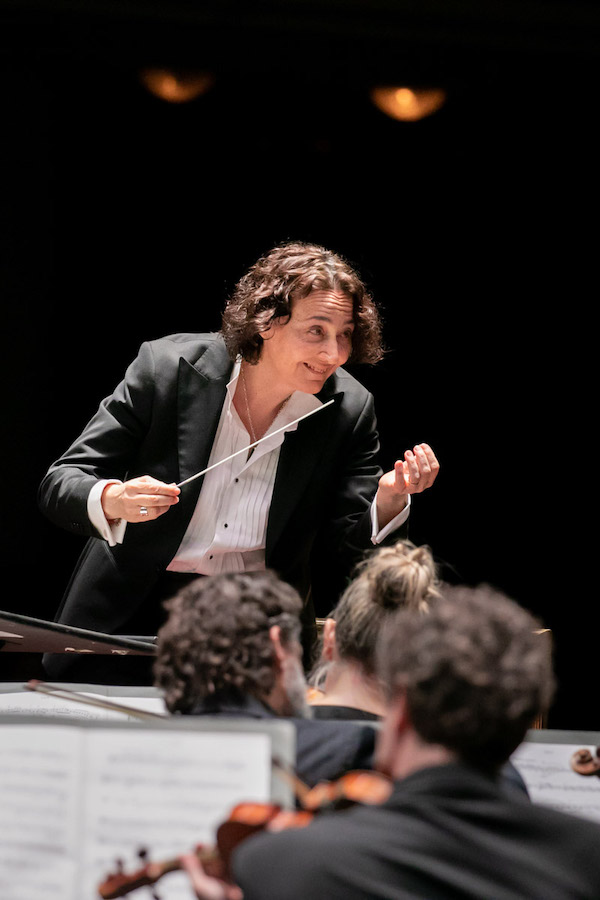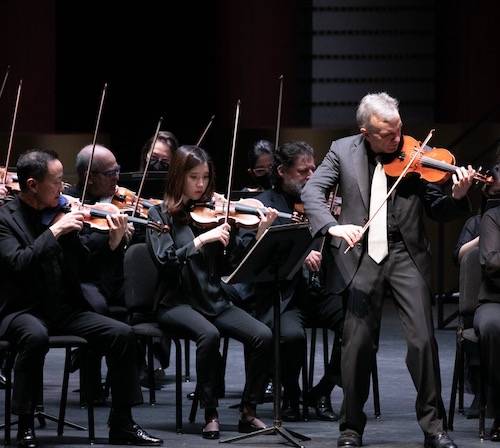Stutzmann, Philadelphia Orchestra make a magnificent showing at the Kravis Center

Nathalie Stutzmann conducted the Philadelphia Orchestra in music of Brahms Monday night at the Kravis Center in West Palm Beach. Photo: Jacek Gancarz
Well, at least Philadelphia still has a magnificent symphony orchestra.
One day after the city’s NFL team blew a halftime lead to lose the Super Bowl, the renowned Philadelphia Orchestra opened a three-concert swing through South Florida, playing an all-Brahms concert Monday evening at the Kravis Center in West Palm Beach.
Leading the orchestra was principal guest conductor Nathalie Stutzmann, an accomplished contralto who made a successful pivot into conducting, recently taking a new position as music director of the Atlanta Symphony Orchestra.
There’s a theatrical flair to Stutzmann’s conducting style. At times, such as before a dark fortissimo chord in the last movement of the Brahms Symphony No. 1, she will raise her arms and hold the orchestra back for a half a beat, then lower her arms to summon a sudden burst of sound that arrives with that much more force and ferocity.
The concert opened with the Brahms Violin Concerto with Gil Shaham as soloist. For this most symphonic of violin concertos, the close collaboration among soloist, conductor and orchestra was clear, both in Shaham’s body language as he faced Stutzmann or faded into the orchestra and in his playing. At times, such as the complex embroidery of violin notes after the solo entrance, Shaham allowed his sound to fade into the background more than most violinists do in favor of melodies in the orchestra, a decision that enhanced the work’s symphonic heft.
The purely orchestral sections were highlights. The long opening introduction came off as particularly ominous, with portentous pauses and every note seeming to aim at the downhill rush toward the climactic solo opening. The roiling orchestral passages throughout the first movement, with the whole orchestra playing over a rumbling timpani, produced sounds that were perfectly balanced, resonant and full of excitement. And there were the relaxed melodies, with the orchestra playing with an easy Viennese charm and grace.

Gil Shaham performed Brahms’ Violin Concerto with the Philadelphia Orchestra Monday night. Photo: Jacek Gancarz
Shaham’s playing of the solo opening, in which the violin seizes control of the music, was indistinct, lacking the force, bite and brilliance to face down the orchestra. But he brought excitement to all the rapid passages that followed, the ascending scales in octaves and the rapid runs up and down the fingerboard. He brought savage force to the upward procession of chords that start on the gritty lower strings, with the multiple notes ringing out clearly.
In many concertos, some of the most stirring music occurs immediately after the cadenza, and that was the case in the Brahms first movement. The close collaboration between Shaham, Stutzmann and the orchestra was particularly fruitful here, as the tangy harmonies of the orchestra occurred with particular prominence and richness without overpowering Shaham’s own melody.
The long opening oboe solo of the Adagio is one of the work’s great passages. Oboe players study it for auditions, and one of the 19th century’s great violinists, Pablo de Sarasate, allegedly refused to play the concerto to avoid the humiliation of standing there while the oboe took the best tune. Principal oboist Philippe Tondre gave a particularly distinguished performance, playing with a gorgeous tone, a natural sense of phrasing and a feel for the melody’s inevitable climax.
At times Shaham’s playing was too self-effacing, with the violin’s melody disappearing into the orchestra. But for the most part, his playing matched the oboe’s in sensitivity, with Shaham maintaining a clear and shining tone all the way up the instrument’s highest string. Shaham brought brilliance and extroversion to the opening of the last movement, blasting out chords and bouncing his bow from string to string with authority and jocular humor.
For sheer gorgeousness of orchestral sonority, it would be hard to beat the orchestra’s performance of the opening of the Brahms Symphony No. 1. The sharp timpani blows that launched the opening bars —nothing like the more refined sound favored by other conductors—established the dramatic course of the introductory movement. With long-held notes and brief rests, Stutzmann maximized the movement’s tension. The ensuing Allegro went off with a sense of coiled energy. But for all the movement’s dramatics, there are moments of repose, and under Stutzmann the orchestra played these in a free and relaxed manner that provided moments of peace before the movement lurched again into high gear.
The Andante was a surging, turbulent episode dominated by the orchestra’s sumptuous string section, with particularly searing power in the sudden ascent of a minor-key melody in the violins. The third movement came off with Olympian jocularity, with the rolling theme conveying bigness and grandeur.
The last movement’s slow introduction was especially pensive and uncertain, setting up the cloud-parting moment when horns and flute soar over the orchestra. Particularly effective were the movement’s final passages—a misty shimmering minor-key interlude that sounded almost Wagnerian in its harmonic murkiness and the gradual, climactic slowing of the pace before the final brass choir.
The Kravis Center’s parade of top-flight orchestras will continue next season. Phillip Bergmann, the Kravis Center’s artistic advisor for classical music, announced from the stage Monday that next season will bring the illustrious Vienna Philharmonic to Kravis for performances of the ninth symphonies of Mahler and Bruckner. Other orchestras scheduled for next season include the orchestras of Cleveland, Detroit, Jacksonville and Rotterdam, as well as the New World Symphony.
The orchestra will perform 8 p.m. Wednesday at the Arsht Center in Miami, playing Dvořák’s Symphony No. 9 “From the New World” and the Brahms Violin Concerto with soloist Gil Shaham. arshtcenter.org
Posted in Performances
Leave a Comment
Tue Feb 14, 2023
at 3:02 pm
No Comments